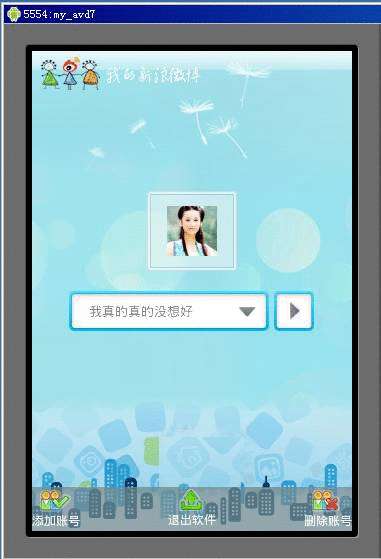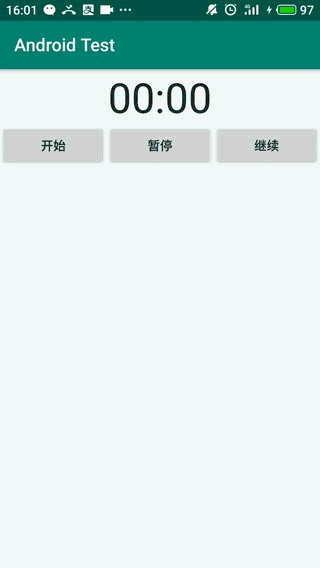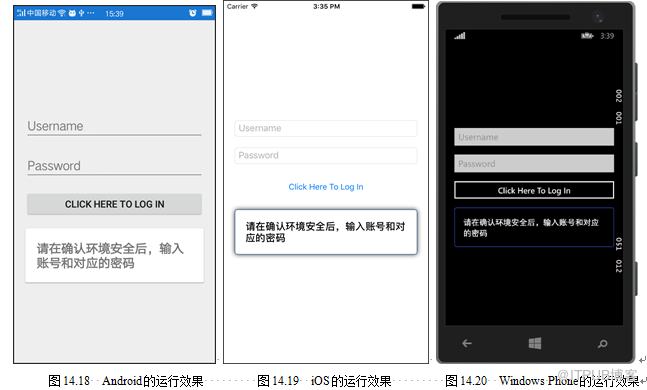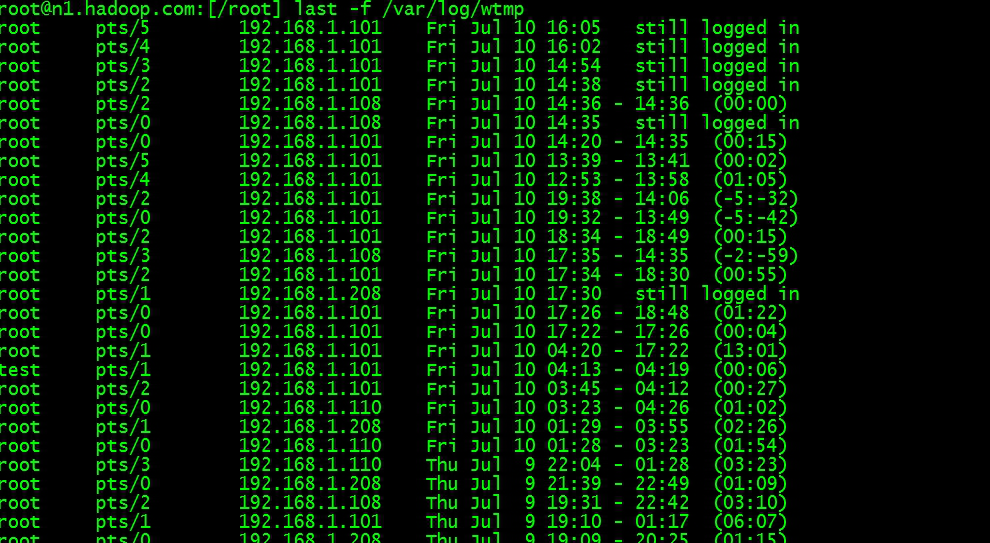android开发我的新浪微博客户端-登录页面UI篇(4.1) 

首先回顾一下功能流程当用户开启软件显示载入页面时程序首先去sqlite库查询是否已经保存有用户的新浪微博的UserID号、Access Token、Access Secret的记录如果没有一条记录那么跳转到用户授权功能页面,这个已经由上面两篇文章实现了,如果有记录那么页面跳转到用户登录页面,也就是本篇以及下篇要实现的功能,本篇讲UI的实现,本项目支持多微博账号了,也就是用户可以设置多个微博账号,登录的时候选择其中的一个登录,具体效果如上图,新建名LoginActivity.java的Activity并且在AndroidManifest.xml中进行相应配置,这个页面就是我们要实现的用户登录页面。
看上面的效果,首先页面分3部分实现,背景部分、底部菜单部分、用户选择以及头像显示部分,首先在res/layout的目录下新建名为login.xml的layout,然后根据页面显示要求编写如下的布局控制:

 代码 xml version="1.0" encoding="utf-8"?>
代码 xml version="1.0" encoding="utf-8"?>
<LinearLayout
xmlns:android&#61;"http://schemas.android.com/apk/res/android"
android:id&#61;"&#64;&#43;id/layout"
android:orientation&#61;"vertical"
android:layout_width&#61;"fill_parent"
android:layout_height&#61;"fill_parent">
<ImageView
android:layout_width&#61;"wrap_content"
android:layout_height&#61;"wrap_content"
android:src&#61;"&#64;drawable/logo_s"
android:layout_marginTop&#61;"5dip"
android:layout_marginLeft&#61;"5dip">
ImageView>
<RelativeLayout
android:layout_width&#61;"fill_parent"
android:layout_height&#61;"fill_parent">
<RelativeLayout
android:id&#61;"&#64;&#43;id/iconBtn"
android:layout_width&#61;"90px"
android:layout_height&#61;"80px"
android:background&#61;"&#64;drawable/icon_selector"
android:layout_above&#61;"&#64;&#43;id/selectLayout"
android:layout_centerHorizontal&#61;"true"
android:layout_marginBottom&#61;"20dip">
<ImageView
android:id&#61;"&#64;&#43;id/icon"
android:layout_width&#61;"wrap_content"
android:layout_height&#61;"wrap_content"
android:layout_centerInParent&#61;"true">
ImageView>
RelativeLayout>
<RelativeLayout
android:id&#61;"&#64;&#43;id/selectLayout"
android:layout_width&#61;"wrap_content"
android:layout_height&#61;"wrap_content"
android:layout_centerInParent&#61;"true">
<EditText
android:id&#61;"&#64;&#43;id/iconSelect"
android:layout_width&#61;"200px"
android:layout_height&#61;"wrap_content"
android:maxLength&#61;"10"
android:paddingLeft&#61;"20px"
android:editable&#61;"false"
android:enabled&#61;"false"
android:textSize&#61;"13px"
android:background&#61;"&#64;drawable/input_over" >
EditText>
<ImageButton
android:id&#61;"&#64;&#43;id/iconSelectBtn"
android:layout_width&#61;"wrap_content"
android:layout_height&#61;"wrap_content"
android:layout_marginRight&#61;"1.0dip"
android:layout_alignTop&#61;"&#64;&#43;id/iconSelect"
android:layout_alignRight&#61;"&#64;&#43;id/iconSelect"
android:layout_alignBottom&#61;"&#64;&#43;id/iconSelect"
android:background&#61;"&#64;drawable/more_selector" >
ImageButton>
<ImageButton
android:id&#61;"&#64;&#43;id/login"
android:layout_width&#61;"40px"
android:layout_height&#61;"40px"
android:layout_marginLeft&#61;"5dip"
android:layout_alignTop&#61;"&#64;&#43;id/iconSelectBtn"
android:layout_toRightOf&#61;"&#64;&#43;id/iconSelectBtn"
android:layout_alignBottom&#61;"&#64;&#43;id/iconSelectBtn"
android:background&#61;"&#64;drawable/btn_in_selector" >
ImageButton>
RelativeLayout>
<RelativeLayout
android:layout_width&#61;"fill_parent"
android:layout_height&#61;"44dip"
android:layout_alignParentBottom&#61;"true"
android:background&#61;"#BB768e95">
<LinearLayout
android:id&#61;"&#64;&#43;id/addLayout"
android:layout_width&#61;"wrap_content"
android:layout_height&#61;"wrap_content"
android:orientation&#61;"vertical"
android:layout_alignParentLeft&#61;"true"
android:gravity&#61;"center"
android:layout_marginTop&#61;"3px">
<ImageButton
android:id&#61;"&#64;&#43;id/addIcon"
android:layout_width&#61;"wrap_content"
android:layout_height&#61;"wrap_content"
android:background&#61;"&#64;drawable/add_selector">
ImageButton>
<TextView
android:layout_width&#61;"wrap_content"
android:layout_height&#61;"wrap_content"
android:textColor&#61;"#ffffff"
android:textSize&#61;"12px"
android:text&#61;"添加账号">
TextView>
LinearLayout>
<LinearLayout
android:id&#61;"&#64;&#43;id/exitLayout"
android:layout_width&#61;"wrap_content"
android:layout_height&#61;"wrap_content"
android:orientation&#61;"vertical"
android:layout_centerInParent&#61;"true"
android:gravity&#61;"center"
android:layout_marginTop&#61;"3px">
<ImageButton
android:id&#61;"&#64;&#43;id/exitIcon"
android:layout_width&#61;"wrap_content"
android:layout_height&#61;"wrap_content"
android:background&#61;"&#64;drawable/exit_selector">
ImageButton>
<TextView
android:layout_width&#61;"wrap_content"
android:layout_height&#61;"wrap_content"
android:textColor&#61;"#ffffff"
android:textSize&#61;"12px"
android:text&#61;"退出软件">
TextView>
LinearLayout>
<LinearLayout
android:id&#61;"&#64;&#43;id/delLayout"
android:layout_width&#61;"wrap_content"
android:layout_height&#61;"wrap_content"
android:orientation&#61;"vertical"
android:layout_alignParentRight&#61;"true"
android:gravity&#61;"center"
android:layout_marginTop&#61;"3px">
<ImageButton
android:id&#61;"&#64;&#43;id/delIcon"
android:layout_width&#61;"wrap_content"
android:layout_height&#61;"wrap_content"
android:background&#61;"&#64;drawable/del_selector">
ImageButton>
<TextView
android:layout_width&#61;"wrap_content"
android:layout_height&#61;"wrap_content"
android:textColor&#61;"#ffffff"
android:textSize&#61;"12px"
android:text&#61;"删除账号">
TextView>
LinearLayout>
RelativeLayout>
RelativeLayout>
LinearLayout> 正对上面的login.xml的layout进行一下说明&#xff0c;背景部分前面已经讲过了这里也就不重复。
底部菜单实现&#xff0c;原本我是采用GridView实现的非常的方便但是后来由于显示位置不好控制改成了用RelativeLayout和LinearLayout嵌套的方式&#xff0c;实现的比较土但是达到了显示需求&#xff0c;首先是一个最外面的RelativeLayout目的是用来实现底部对齐显示&#xff0c;并且把这个RelativeLayout的背景设置为浅蓝色半透明的效果&#xff0c;关键这2行&#xff1a;android:layout_alignParentBottom&#61;"true"和android:background&#61;"#BB768e95"。然后是在RelativeLayout内部添加3个LinearLayout分别是用来显示添加账号、退出软件、删除账号3个功能按钮菜单&#xff0c;并且分别设置为左对齐、居中对齐、右对齐&#xff0c;3个LinearLayout都设置为垂直布局android:orientation&#61;"vertical"&#xff0c;然后每LinearLayout添加相应的图片和文字。
用户选择以及头像显示部分&#xff0c;这块分成3小块&#xff0c;用来显示用户头像的ImageView、用来显示用户名字并且点击可以出现选择列表的EditText、用来点击进入当前选择用户首页的功能按钮ImageButton&#xff0c;这3小块的布局实现也是采用elativeLayout和LinearLayout相互嵌套配合的方式实现的具体参考login.xml。这里重点说说这个账号选择列表弹出窗口的实现&#xff0c;当点击下拉箭头按钮的时候弹出并显示&#xff0c;这个是用Dialog控件实现&#xff0c;首先准备好圆角的半透明背景图mask_bg.png然后添加到res/drawable-mdpi文件夹下&#xff0c;接着自定义一个Dialog样式文件&#xff0c;在res/values目录下新建名为dialogStyles2.xml的resources文件&#xff0c;在用户授权验证页面的时候我们也自定义过类似的Dialog的样式&#xff0c;具体解释可以参考前面的户授权验证页面功能&#xff0c;内容如下&#xff1a;
 代码
代码
xml version&#61;"1.0" encoding&#61;"utf-8"?>
<resources>
<style name&#61;"dialog2" parent&#61;"&#64;android:style/Theme.Dialog">
<item name&#61;"android:windowFrame">&#64;nullitem>
<item name&#61;"android:windowIsFloating">trueitem>
<item name&#61;"android:windowIsTranslucent">falseitem>
<item name&#61;"android:windowNoTitle">trueitem>
<item name&#61;"android:windowBackground">&#64;drawable/mask_bgitem>
<item name&#61;"android:backgroundDimEnabled">trueitem>
style>
resources> 接下来还需要定义选择列表的layout&#xff0c;新建名为dialog2.xml的layout文件&#xff0c;内容如下&#xff1a;
 代码
代码
xml version&#61;"1.0" encoding&#61;"utf-8"?>
<LinearLayout
xmlns:android&#61;"http://schemas.android.com/apk/res/android"
android:layout_width&#61;"wrap_content"
android:layout_height&#61;"wrap_content"
android:orientation&#61;"vertical"
android:padding&#61;"4dip">
<ListView
android:id&#61;"&#64;&#43;id/list"
android:layout_width&#61;"240px"
android:layout_height&#61;"220px"
android:divider&#61;"#f1f2f2"
android:dividerHeight&#61;"1px"
android:layout_margin&#61;"5px"
android:background&#61;"#ffffff"
android:cacheColorHint&#61;"#00000000">
ListView>
LinearLayout>
完成了layout和样式文件的编写&#xff0c;接下来就是把dialogStyles2.xml样式文件和dialog2.xml的列表layout用起来&#xff0c;当点击id为iconSelectBtn的ImageButton时显示用户选择窗口&#xff0c;在LoginActivity的onCreate方法中添加如下代码&#xff1a;

 代码 public void onCreate(Bundle savedInstanceState) {
代码 public void onCreate(Bundle savedInstanceState) {
super.onCreate(savedInstanceState);
setContentView(R.layout.login);
LinearLayout layout&#61;(LinearLayout)findViewById(R.id.layout);
//背景自动适应
AndroidHelper.AutoBackground(this, layout, R.drawable.bg_v, R.drawable.bg_h);
ImageButton iconSelectBtn&#61;(ImageButton)findViewById(R.id.iconSelectBtn);
iconSelectBtn.setOnClickListener(new OnClickListener(){
&#64;Override
public void onClick(View v) {
View diaView&#61;View.inflate(LoginActivity.this, R.layout.dialog2, null);
dialog&#61;new Dialog(LoginActivity.this,R.style.dialog2);
dialog.setContentView(diaView);
dialog.show();
......
}
});
到这里登录的UI部分就实现的差不多了&#xff0c;剩下的都是一些功能部分代码用来实现从sqlite中账号列表的获取&#xff0c;以及点击选择等交互操作等&#xff0c;这些在下一篇中来继续的讲。
分类: Andr


首先回顾一下功能流程当用户开启软件显示载入页面时程序首先去sqlite库查询是否已经保存有用户的新浪微博的UserID号、Access Token、Access Secret的记录如果没有一条记录那么跳转到用户授权功能页面&#xff0c;这个已经由上面两篇文章实现了&#xff0c;如果有记录那么页面跳转到用户登录页面&#xff0c;也就是本篇以及下篇要实现的功能&#xff0c;本篇讲UI的实现&#xff0c;本项目支持多微博账号了&#xff0c;也就是用户可以设置多个微博账号&#xff0c;登录的时候选择其中的一个登录&#xff0c;具体效果如上图,新建名LoginActivity.java的Activity并且在AndroidManifest.xml中进行相应配置&#xff0c;这个页面就是我们要实现的用户登录页面。
看上面的效果&#xff0c;首先页面分3部分实现&#xff0c;背景部分、底部菜单部分、用户选择以及头像显示部分&#xff0c;首先在res/layout的目录下新建名为login.xml的layout&#xff0c;然后根据页面显示要求编写如下的布局控制&#xff1a;

 代码
代码 <LinearLayout
xmlns:android&#61;"http://schemas.android.com/apk/res/android"
android:id&#61;"&#64;&#43;id/layout"
android:orientation&#61;"vertical"
android:layout_width&#61;"fill_parent"
android:layout_height&#61;"fill_parent">
<ImageView
android:layout_width&#61;"wrap_content"
android:layout_height&#61;"wrap_content"
android:src&#61;"&#64;drawable/logo_s"
android:layout_marginTop&#61;"5dip"
android:layout_marginLeft&#61;"5dip">
ImageView>
<RelativeLayout
android:layout_width&#61;"fill_parent"
android:layout_height&#61;"fill_parent">
<RelativeLayout
android:id&#61;"&#64;&#43;id/iconBtn"
android:layout_width&#61;"90px"
android:layout_height&#61;"80px"
android:background&#61;"&#64;drawable/icon_selector"
android:layout_above&#61;"&#64;&#43;id/selectLayout"
android:layout_centerHorizontal&#61;"true"
android:layout_marginBottom&#61;"20dip">
<ImageView
android:id&#61;"&#64;&#43;id/icon"
android:layout_width&#61;"wrap_content"
android:layout_height&#61;"wrap_content"
android:layout_centerInParent&#61;"true">
ImageView>
RelativeLayout>
<RelativeLayout
android:id&#61;"&#64;&#43;id/selectLayout"
android:layout_width&#61;"wrap_content"
android:layout_height&#61;"wrap_content"
android:layout_centerInParent&#61;"true">
<EditText
android:id&#61;"&#64;&#43;id/iconSelect"
android:layout_width&#61;"200px"
android:layout_height&#61;"wrap_content"
android:maxLength&#61;"10"
android:paddingLeft&#61;"20px"
android:editable&#61;"false"
android:enabled&#61;"false"
android:textSize&#61;"13px"
android:background&#61;"&#64;drawable/input_over" >
EditText>
<ImageButton
android:id&#61;"&#64;&#43;id/iconSelectBtn"
android:layout_width&#61;"wrap_content"
android:layout_height&#61;"wrap_content"
android:layout_marginRight&#61;"1.0dip"
android:layout_alignTop&#61;"&#64;&#43;id/iconSelect"
android:layout_alignRight&#61;"&#64;&#43;id/iconSelect"
android:layout_alignBottom&#61;"&#64;&#43;id/iconSelect"
android:background&#61;"&#64;drawable/more_selector" >
ImageButton>
<ImageButton
android:id&#61;"&#64;&#43;id/login"
android:layout_width&#61;"40px"
android:layout_height&#61;"40px"
android:layout_marginLeft&#61;"5dip"
android:layout_alignTop&#61;"&#64;&#43;id/iconSelectBtn"
android:layout_toRightOf&#61;"&#64;&#43;id/iconSelectBtn"
android:layout_alignBottom&#61;"&#64;&#43;id/iconSelectBtn"
android:background&#61;"&#64;drawable/btn_in_selector" >
ImageButton>
RelativeLayout>
<RelativeLayout
android:layout_width&#61;"fill_parent"
android:layout_height&#61;"44dip"
android:layout_alignParentBottom&#61;"true"
android:background&#61;"#BB768e95">
<LinearLayout
android:id&#61;"&#64;&#43;id/addLayout"
android:layout_width&#61;"wrap_content"
android:layout_height&#61;"wrap_content"
android:orientation&#61;"vertical"
android:layout_alignParentLeft&#61;"true"
android:gravity&#61;"center"
android:layout_marginTop&#61;"3px">
<ImageButton
android:id&#61;"&#64;&#43;id/addIcon"
android:layout_width&#61;"wrap_content"
android:layout_height&#61;"wrap_content"
android:background&#61;"&#64;drawable/add_selector">
ImageButton>
<TextView
android:layout_width&#61;"wrap_content"
android:layout_height&#61;"wrap_content"
android:textColor&#61;"#ffffff"
android:textSize&#61;"12px"
android:text&#61;"添加账号">
TextView>
LinearLayout>
<LinearLayout
android:id&#61;"&#64;&#43;id/exitLayout"
android:layout_width&#61;"wrap_content"
android:layout_height&#61;"wrap_content"
android:orientation&#61;"vertical"
android:layout_centerInParent&#61;"true"
android:gravity&#61;"center"
android:layout_marginTop&#61;"3px">
<ImageButton
android:id&#61;"&#64;&#43;id/exitIcon"
android:layout_width&#61;"wrap_content"
android:layout_height&#61;"wrap_content"
android:background&#61;"&#64;drawable/exit_selector">
ImageButton>
<TextView
android:layout_width&#61;"wrap_content"
android:layout_height&#61;"wrap_content"
android:textColor&#61;"#ffffff"
android:textSize&#61;"12px"
android:text&#61;"退出软件">
TextView>
LinearLayout>
<LinearLayout
android:id&#61;"&#64;&#43;id/delLayout"
android:layout_width&#61;"wrap_content"
android:layout_height&#61;"wrap_content"
android:orientation&#61;"vertical"
android:layout_alignParentRight&#61;"true"
android:gravity&#61;"center"
android:layout_marginTop&#61;"3px">
<ImageButton
android:id&#61;"&#64;&#43;id/delIcon"
android:layout_width&#61;"wrap_content"
android:layout_height&#61;"wrap_content"
android:background&#61;"&#64;drawable/del_selector">
ImageButton>
<TextView
android:layout_width&#61;"wrap_content"
android:layout_height&#61;"wrap_content"
android:textColor&#61;"#ffffff"
android:textSize&#61;"12px"
android:text&#61;"删除账号">
TextView>
LinearLayout>
RelativeLayout>
RelativeLayout>
LinearLayout>
正对上面的login.xml的layout进行一下说明&#xff0c;背景部分前面已经讲过了这里也就不重复。
底部菜单实现&#xff0c;原本我是采用GridView实现的非常的方便但是后来由于显示位置不好控制改成了用RelativeLayout和LinearLayout嵌套的方式&#xff0c;实现的比较土但是达到了显示需求&#xff0c;首先是一个最外面的RelativeLayout目的是用来实现底部对齐显示&#xff0c;并且把这个RelativeLayout的背景设置为浅蓝色半透明的效果&#xff0c;关键这2行&#xff1a;android:layout_alignParentBottom&#61;"true"和android:background&#61;"#BB768e95"。然后是在RelativeLayout内部添加3个LinearLayout分别是用来显示添加账号、退出软件、删除账号3个功能按钮菜单&#xff0c;并且分别设置为左对齐、居中对齐、右对齐&#xff0c;3个LinearLayout都设置为垂直布局android:orientation&#61;"vertical"&#xff0c;然后每LinearLayout添加相应的图片和文字。
用户选择以及头像显示部分&#xff0c;这块分成3小块&#xff0c;用来显示用户头像的ImageView、用来显示用户名字并且点击可以出现选择列表的EditText、用来点击进入当前选择用户首页的功能按钮ImageButton&#xff0c;这3小块的布局实现也是采用elativeLayout和LinearLayout相互嵌套配合的方式实现的具体参考login.xml。这里重点说说这个账号选择列表弹出窗口的实现&#xff0c;当点击下拉箭头按钮的时候弹出并显示&#xff0c;这个是用Dialog控件实现&#xff0c;首先准备好圆角的半透明背景图mask_bg.png然后添加到res/drawable-mdpi文件夹下&#xff0c;接着自定义一个Dialog样式文件&#xff0c;在res/values目录下新建名为dialogStyles2.xml的resources文件&#xff0c;在用户授权验证页面的时候我们也自定义过类似的Dialog的样式&#xff0c;具体解释可以参考前面的户授权验证页面功能&#xff0c;内容如下&#xff1a;
 代码
代码
<resources>
<style name&#61;"dialog2" parent&#61;"&#64;android:style/Theme.Dialog">
<item name&#61;"android:windowFrame">&#64;nullitem>
<item name&#61;"android:windowIsFloating">trueitem>
<item name&#61;"android:windowIsTranslucent">falseitem>
<item name&#61;"android:windowNoTitle">trueitem>
<item name&#61;"android:windowBackground">&#64;drawable/mask_bgitem>
<item name&#61;"android:backgroundDimEnabled">trueitem>
style>
resources>
接下来还需要定义选择列表的layout&#xff0c;新建名为dialog2.xml的layout文件&#xff0c;内容如下&#xff1a;
 代码
代码
<LinearLayout
xmlns:android&#61;"http://schemas.android.com/apk/res/android"
android:layout_width&#61;"wrap_content"
android:layout_height&#61;"wrap_content"
android:orientation&#61;"vertical"
android:padding&#61;"4dip">
<ListView
android:id&#61;"&#64;&#43;id/list"
android:layout_width&#61;"240px"
android:layout_height&#61;"220px"
android:divider&#61;"#f1f2f2"
android:dividerHeight&#61;"1px"
android:layout_margin&#61;"5px"
android:background&#61;"#ffffff"
android:cacheColorHint&#61;"#00000000">
ListView>
LinearLayout>
完成了layout和样式文件的编写&#xff0c;接下来就是把dialogStyles2.xml样式文件和dialog2.xml的列表layout用起来&#xff0c;当点击id为iconSelectBtn的ImageButton时显示用户选择窗口&#xff0c;在LoginActivity的onCreate方法中添加如下代码&#xff1a;

 代码
代码 super.onCreate(savedInstanceState);
setContentView(R.layout.login);
LinearLayout layout&#61;(LinearLayout)findViewById(R.id.layout);
//背景自动适应
AndroidHelper.AutoBackground(this, layout, R.drawable.bg_v, R.drawable.bg_h);
ImageButton iconSelectBtn&#61;(ImageButton)findViewById(R.id.iconSelectBtn);
iconSelectBtn.setOnClickListener(new OnClickListener(){
&#64;Override
public void onClick(View v) {
View diaView&#61;View.inflate(LoginActivity.this, R.layout.dialog2, null);
dialog&#61;new Dialog(LoginActivity.this,R.style.dialog2);
dialog.setContentView(diaView);
dialog.show();
......
}
});
到这里登录的UI部分就实现的差不多了&#xff0c;剩下的都是一些功能部分代码用来实现从sqlite中账号列表的获取&#xff0c;以及点击选择等交互操作等&#xff0c;这些在下一篇中来继续的讲。











 京公网安备 11010802041100号
京公网安备 11010802041100号